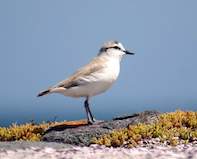
Name
White-fronted plover (Charadrius marginatus)Family
CharadriidaeLength
9 cmAppearance
The adult white-fronted plover is white below and grey-brown above. The eyes are brown and the bill and legs are black. The male has a more conspicuous black line behind the eye and usually small dark patches on the sides of the breast.
The female have a similar appearance to adult males but the black crown band is less defined and may even be absent. The immature plover lacks any black on the head but a white band across the nape is present. The nestling is grey mottled above and white below with black forming lines down the centre of the crown.
White-Fronted Plover
In flight the call is a soft ‘wit’ or ‘twit’ or ‘twirit’. When disturbed a loud ‘kittup’ or a long drawn out ‘churr’ is heard.White-Fronted Plover Diet
The white-fronted plover mainly eats insects and aquatic invertebrates. It forages by day and night using the typical technique of plovers.
The plover runs across the ground, stops and then searches for prey to pluck from the ground. It also stands while trembling its feet which disturbs invertebrates.
White-Fronted Plover Breeding
White-fronted plovers breed throughout the year but mainly August - September in South Africa. On hot days the eggs are three-quarters covered with wind-blown sand.
There are usually two pointed oval, creamy buff eggs marked with a fine line of dark brown scattered over the surface. Incubation takes 27-33 days and the young leave the nest after about 35-38 days.